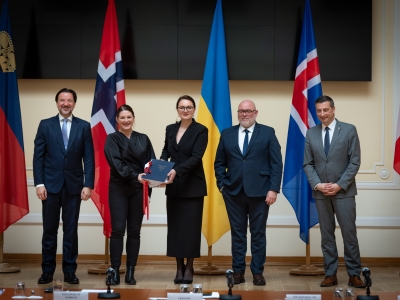About
The EFTA States signed a Free Trade Agreement with Ukraine in Reykjavik, Iceland, on 24 June 2010. On 2 December 2024, EFTA and Ukraine concluded negotiations on the modernisation of their free trade agreement and it was signed in Kyiv on 8 April 2025 . Further details on the modernised agreement can be found in a Chapter by Chapter Fact Sheet.
The modernisation process was formally launched during the EFTA Ministerial Meeting held in Schaan, Liechtenstein, in June 2023. The Parties met for a first round of negotiations on 3-4 April 2024. Two rounds of negotiations took place, with the final round held in Geneva, Switzerland, in August 2024.
Key facts
- Population
38,000,000
- GDP
$ 160,502.74 M
- Date of Signature of the Agreement
24.06.2010
(FTA)
Negotiations ongoing
(modernised FTA)
- Date of Entry Into Force
01.06.2012
(FTA)
N/A
(modernised FTA)
- Imports to EFTA States
EUR 241 M
- Exports from EFTA States
EUR 782 M
Information about agreement
Summary
The Free Trade Agreement has a comprehensive coverage, including trade in goods (industrial and processed agricultural goods, fish and other marine products), trade in services, investment, protection of intellectual property rights, government procurement and provisions on competition.
Bilateral arrangements on agricultural products between the individual EFTA States and Ukraine also form part of the instruments establishing the free trade area between both sides.
Content of the Free Trade Agreement
The Agreement consists of 10 Chapters, 15 Annexes and a Protocol. The Agreement covers the following main subjects:
- Trade in Goods
- Rules of Origin
- Trade Facilitation
- Sanitary and Phytosanitary Measures (SPS)
- Technical Barriers to Trade (TBT)
- Trade Remedies
- Trade in Services
- Investment/Establishment
- Protection of Intellectual Property (IPR)
- Government Procurement
- Competition
- Institutional Provisions
- Dispute Settlement
Trade in Goods
Industrial Goods and Fish and marine products
Industrial goods originating in Ukraine, including fish and other marine products, will benefit from duty-free access to the markets of the EFTA States as of the entry into force of the Agreement (Chapter 2). For such products originating in the EFTA States and imported into Ukraine, most customs duties will be zero from the entry into force as well, while the majority of the others will progressively be dismantled over transitional periods of up to 10 years (Annexes III and IV).
Agricultural products
The Agreement provides for tariff concessions on processed agricultural products (Annex II). Tariff concessions on basic agricultural products are covered by the bilateral agricultural agreements, which are part of the instruments establishing a free trade area between the Parties.
Rules of Origin
The Rules of Origin and the methods of administrative cooperation set out in the Protocol on Rules of Origin and its seven Appendices are based on the pan-Euro-Mediterranean (PEM) model text. This will allow for cumulation of materials originating in the EFTA States, Ukraine and the other PEM member countries once the respective agreements are in place between those countries and Ukraine.
Trade Facilitation
The Agreement includes provisions on trade facilitation (Annex V).
Sanitary and Phytosanitary Measures (SPS)
The Agreement includes provisions on sanitary and phytosanitary measures in conformity with the relevant WTO Agreements.
Technical Barriers to Trade (TBT)
The Agreement includes provisions on technical regulations in conformity with the relevant WTO Agreements.
Trade Remedies
The Agreement includes provisions on trade remedies and exceptions in conformity with the relevant WTO Agreements.
Trade in Services
The Chapter on trade in services (Chapter 3) closely follows the WTO General Agreement on Trade in Services (GATS). It covers trade in all services sectors under all four modes of supply, with the exception of air traffic. Separate annexes on financial services (Annex IX) and on telecommunications services (Annex X) complement the Chapter with additional disciplines that are of specific relevance to these sectors. The Parties’ specific commitments and MFN Exemptions are contained in Annexes VII and VIII respectively.
Investment/Establishment
Chapter 4 aims to improve the legal framework conditions for investors from EFTA and Ukraine investing in each other’s markets in sectors not covered by the chapter on trade in services. The Agreement provides both for non-discriminatory market access for direct investments and for fair, equitable and non-discriminatory treatment of existing investments. For a few areas, the Parties have lodged reservations based on restrictions in their national legislation (Annexes XI and XII).
Protection of Intellectual Property (IPR)
The Agreement contains a comprehensive Chapter and Annex on intellectual property rights (Chapter 5 and Annex XIII) covering all fields of IPR as well as measures relating to enforcement. The Chapter is based on the WTO Agreement on Trade-Related Aspects of Intellectual Property Rights (TRIPS) and includes certain improvements and clarifications with respect to TRIPS.
Government Procurement
The Agreement provides for access to the Parties’ government procurement markets on a reciprocal basis. While the principles can be found in Chapter 6, more detailed provisions are contained in Annex XIV and the list of covered entities, thresholds and other country-specific provisions in Annex XV.
The relevant provisions stipulate what procedures must be followed by government entities which are procuring goods, services and construction services above a certain threshold. The provisions are closely aligned with the revised WTO Agreement on Government Procurement, adapted to reflect the specific interests of the Parties.
Competition
The Parties recognise that anti-competitive business practices have the potential to undermine the benefits of liberalisation arising from the Agreement and highlight the importance to cooperate on issues relating to competition law enforcement (Article 7).
Institutional Provisions
The Agreement establishes a Joint Committee, which supervises and administers the Agreement and oversees its further development (Chapter 8). The Joint Committee may take decisions in cases provided for by the Agreement and make recommendations in other matters.
Dispute Settlement
Chapter 9 contains rules and procedures for the settlement of disputes arising from the Agreement between one or more EFTA States and Ukraine.
Free Trade Agreement
Annexes and Record of Understanding
PAPs notifications
Bilateral Agreements on Agriculture
Agricultural Agreements
Iceland - Ukraine - Agreement on Agriculture
Amendment to the Agriculture Agreement to implement the PEM Convention - Iceland - Ukraine
Norway - Ukraine - Agreement on Agriculture
Amendment to the Agriculture Agreement to implement the PEM Convention - Norway - Ukraine
Switzerland - Ukraine - Agreement on Agriculture
Amendment to the Agriculture Agreement to implement the PEM Convention - Switzerland - Ukraine
Joint Committee Decisions
| Decision | Subject | Adopted | Entry into force |
|---|---|---|---|
| 2013 | |||
| No. 1/2013 | Rules of Procedure | 29.05.2013 | 29.05.2013 |
| 2025 | |||
| No 1/2025 | Amending the Protocol on Rules of Origin | 08.04.2025 | Pending |
Joint Declaration on Cooperation
Modernised Free Trade Agreement 2025 - not yet in force
| Main Agreement |
| Table of Contents |
Statistics
For EFTA-Ukraine trade statistics, see EFTA Trade Statistics Tool


